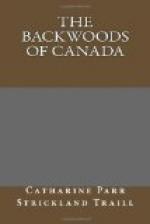The weanling calves should be given skimmed milk or buttermilk, with the leafy boughs of basswood and maple, of which they are extremely fond. A warm shed or fenced yard is very necessary for the cattle during the intense winter frosts: this is too often disregarded, especially in new settlements, which is the cause that many persons have the mortification of losing their stock, either with disease or cold. Naturally the Canadian cattle are very hardy, and when taken moderate care of, endure the severest winters well; but owing to the difficulties that attend a first settlement in the bush, they suffer every privation of cold and hunger, which brings on a complaint generally fatal, called the “hollow horn;” this originates in the spine, or extends to it, and is cured or palliated by boring the horn and inserting turpentine, pepper, or other heating substances.
When a new comer has not winter food for his cattle, it is wise to sell them in the fall and buy others in the spring: though at a seeming loss, it is perhaps less loss in reality than losing the cattle altogether. This was the plan my husband adopted, and we found it decidedly the better one, besides saving much care, trouble, and vexation.
I have seen some good specimens of native cheese, that I thought very respectable, considering that the grass is by no means equal to our British pastures. I purpose trying my skill next summer: who knows but that I may inspire some Canadian bard to celebrate the produce of my dairy as Bloomfield did the Suffolk cheese, yclept “Bang.” You remember the passage,—for Bloomfield is your countryman as well as mine,—it begins:
“Unrivalled stands thy county cheese, O Giles,” &c.
I have dwelt on the dairy information; as I know you were desirous of imparting all you could collect to your friends.
You wish to know something of the culture of Indian corn, and if it be a useful and profitable crop.
The cultivation of Indian corn on newly cleared lands is very easy, and attended with but little labour; on old farms it requires more. The earth is just raised with a broad hoe, and three or four corns dropped in with a pumpkin-seed, in about every third or fourth hole, and in every alternate row; the seed are set several feet apart. The pumpkins and the corn grow very amicably together, the broad leaves of the former shading the young plants and preventing the




